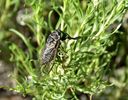Okanagana
Okanagana
Classification
- Phylum: Arthropoda
- Subphylum: Hexapoda
- Class: Insecta
- Order: Hemiptera
- Suborder: Auchenorrhyncha
- Infraorder: Cicadomorpha
- Superfamily: Cicadoidea
- Family: Cicadidae
- Subfamily: Tibicininae
- Tribe: Tibicinini
- Genus: Okanagana
Pronunciation
How to pronounce Okanagana: /ˌoʊ.kəˈnæ.ɡə.nə/
These audio files are automatically generated. While they are not always 100% accurate, they are a good starting point.
Images






Summary
Okanagana is a genus of cicadas within the family Cicadidae. Known for their diverse species and complex life cycles, these cicadas are often identified through their acoustic calls and careful morphological examinations. The genus was first described in 1905 and has 58 described species, primarily located in North America.
Physical Characteristics
Species range from 20-35mm in body length, with some smaller. Wingspan is approximately 50-80mm.
Identification Tips
Males should be identified using a dorsal and ventral shot, an exposed wing, and dorsal and lateral views of the uncus. Females require dorsal and ventral shots with a closeup of the female genital plates. Songs are also essential for identification, as there is little intraspecific variation, and song metrics can help distinguish species.
Habitat
Varies widely; some are host plant specific or habitat specific: O. nigriviridis (chamise), O. opacipennis, O. rubrovenosa, O. arctostaphylae (manzanita), O. villosa (subalpine), O. balli (tallgrass prairie), O. viridis (deciduous forest).
Distribution
Most speciose in California, with ranges into the Midwest and across Canada. Okanagana viridis is found in the southeastern deciduous regions of Oklahoma and Texas, while O. aurantiaca is located in Baja, although not recorded in recent history.
Diet
Specific host plants vary by species; detailed positive identification of diet by each species not provided.
Life Cycle
Average lifecycle is protoperiodical, lasting 2-5 years with variable emergences. Some species' emergence is governed by cumulative rainfall thresholds.
Reproduction
Reproductive behaviors and timing not specifically detailed, but emergence patterns are influenced by environmental conditions and rainfall.
Evolution
Recent phylogenetic studies have led to reclassification of some species into other genera including Chlorocanta, Hewlettia, and Tibicinoides.
Similar Taxa
Tags
- Cicadas
- Okanagana
- Cicadidae
- Hymenoptera
- Insect Identification